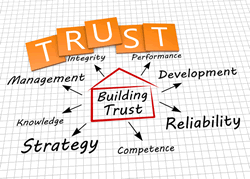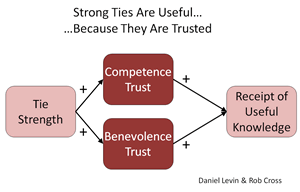 Organizations have been facing a challenge for several years now: a lack of trust among people regarding what they say, the messages they spread and how they act. Relationships are based upon trust. Although the levels and types of trust are different, this goes for business relationships as well.
Organizations have been facing a challenge for several years now: a lack of trust among people regarding what they say, the messages they spread and how they act. Relationships are based upon trust. Although the levels and types of trust are different, this goes for business relationships as well.
Trust, social proof and reputation go hand in hand and are directly related to the intensity and value of the relationship between a business and its’ customers and other partners.
Trust regarding what businesses say and do has been decreasing. It’s one of the reasons why many marketers try to embrace social media marketing and a more conversational style in their customer-oriented tactics in which darn good content across multiple touchpoints, the purpose of content marketing, plays a key role.
Trust is fundamental in all sorts of relationships. However, it’s also a very fluffy word, and it shouldn’t be taken too lightly. It is related to honesty and fairness. It is also related to competence in which case it is maybe better to call it confidence.
Four ways to regain trust
Reconnecting your brand means earning attention of people, but most of all it means earning trust.
1. Be clear and transparent
Many organizations can be more transparent than they are today, opening themselves up for interaction and participation. More important than transparency is clarity: what are your intentions and promises when interacting and doing business with people? What can they really expect? The need for clarity applies to numerous domains. Think about handling the personal data of your customers, for instance, and the need of a clear privacy policy. Privacy increasingly becomes something that needs to be earned. However, clarity is also about making the customer experience as transparent and evident as possible: no unexpected surprises and removing everything that stands in the way of people fulfilling their needs. That’s what user-friendliness is about. Finally, clarity is also about your promises. People expect something when entering in a marketing or other business relationship. It’s important to set these expectations right and not overpromise. At the same time, it’s essential to make sure that expectations are clear in order to avoid disappointment.
2. When trust meets conversions: live up to your promises
Once the mutual expectations are set, and people know how you will deal with their data, follow up on their questions or any sort of interaction and transaction, it’s important to live up to these promises and expectations. It’s the basis of trust but also of branding and conversion or marketing optimization. In the end, conversions and business transactions only happen when there is a level of trust. Even social sharing and content sharing in general requires trust. For lesser-known brands that is sometimes a challenge, but it doesn’t have to. The other way around, sometimes bigger brands can have trust challenges that smaller competitors don’t have. Using different ways to establish credibility and trust is essential in optimizing conversions. However, the key differentiator is to actually live up to what you promise by using them.
3. Keep the multi-channel lines open

No one is perfect. Living up 200% to promises and proving perfect customer experiences is a goal to strive towards. However, things happen, after all we are human beings. Even if you’re totally clear and do everything you can to live up to your promises, something can go wrong. Your product can be DOA. Someone in your marketing team can make an error, leading to a situation in which the expectations are not met and promises are broken. This is why it’s important to allow people to get in touch with you fast and across the channels they prefer to use. Customer service is about customers and about making sure that the expectations are met. However, it’s also about being there when things do go wrong and even before they can go wrong. Watching over potential errors or unmet promises and, more importantly, talking about them by being attentive, listening to feedback, monitoring, surveying and responding in a…clear and transparent way, is essential to regain trust and reconnect your brand. Good analysis to understand the hurdles and potential problems when interacting with customers and prospects is part of this as well.
4. Nurture the relationship: going beyond trust
Even the happiest and most loyal customer can become upset once you stop paying attention to him. The other way around, there are always people with high buying potential in your list that never become good customers because they are overlooked and don’t receive what they need to go beyond basic trust and become loyal customers or even advocates. Generating revenue is directly related to providing value. In impersonal approaches, whereby a single customer view is lacking; it’s nearly impossible to offer the value, information or simply tools, contacts, interactions and services your customers want. To achieve that single view, integrating customer and marketing data across contact moments is a must, tapping into all your data sources to give you a central 360° customer view. People also want to voice their opinions now and then, so invite them to, for instance, via surveys and other feedback mechanisms. Obviously, developing a relationship in marketing is also about lead nurturing, which is about content, offers, scenarios etc. but most of all about caring, in the end what nurturing means.
These four tips are really not about marketing and business alone. In fact, you could apply them to human relationships in general: talk, listen, be clear, do what you promise, etc… However, in marketing we sometimes forget them or simply don’t have the processes and tools to make it all happen.
Images purchased under license from Shutterstock






